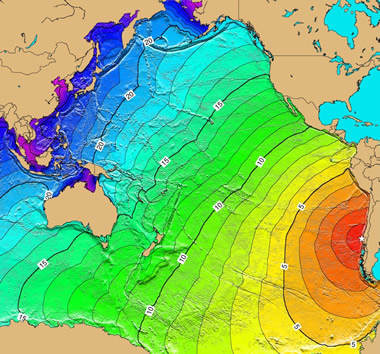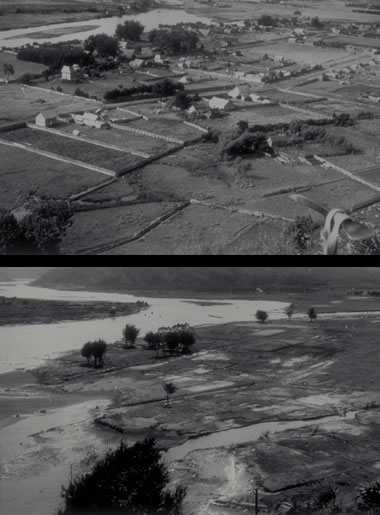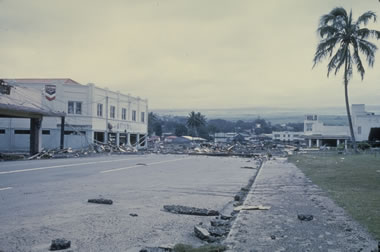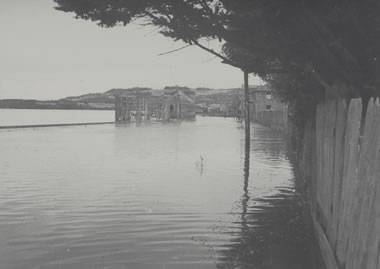Information for comparison purposes of the 2010 Chilean quake
https://en.wikipedia.org/wiki/2010_Chile_earthquake
The 2010 Chile earthquake (Spanish: Terremoto del 27F) occurred off the coast of central Chile on Saturday, 27 February at 03:34 local time (06:34 UTC), having a magnitude of 8.8 on the moment magnitude scale, with intense shaking lasting for about three minutes.[5][1][2][6] It ranks as the fifth largest earthquake ever to be recorded by a seismograph. It was felt strongly in six Chilean regions (from Valparaíso in the north to Araucanía in the south), that together make up about 80 percent of the country's population. According to the United States Geological Survey (USGS) the cities experiencing the strongest shaking—VIII (Severe) on the Mercalli intensity scale (MM)—were Concepción, Arauco and Coronel. According to Chile's Seismological Service Concepción experienced the strongest shaking at MM IX (Violent).[1] The earthquake was felt in the capital Santiago at MM VII (Very strong)[3] or MM VIII.[1] Tremors were felt in many Argentine cities, including Buenos Aires, Córdoba, Mendoza and La Rioja.[7][8] Tremors were felt as far north as the city of Ica in southern Peru (approx. 2,400 km (1,500 mi) away).[9]
The earthquake triggered a tsunami which devastated several coastal towns in south-central Chile and damaged the port at Talcahuano. Tsunami warnings were issued in 53 countries,[10] and the wave caused minor damage in the San Diego area of California[11] and in the Tōhoku region of Japan, where damage to the fisheries business was estimated at ¥6.26 billion (US$66.7 million).[12] The earthquake also generated a blackout that affected 93 percent of the Chilean population and which went on for several days in some locations.[13] President Michelle Bachelet declared a "state of catastrophe" and sent military troops to take control of the most affected areas. According to official sources, 525 people lost their lives, 25 people went missing[4] and about 9% of the population in the affected regions lost their homes.[14]
On 10 March, Swiss Reinsurance Co. estimated that the Chilean quake would cost insurance companies between 4 and 7 billion dollars. The rival German-based Munich Re AG made the same estimate.[15] Earthquake's losses to the economy of Chile are estimated at US$15–30 billion.[16]
Location[edit]
According to the USGS the epicenter of the earthquake was about 3 km (1.9 miles) off the coast of Pelluhue commune in the Maule Region. This is about 6 km (3.7 miles) west of the village of Chovellén, 15 km (9.3 miles) southwest of the town of Pelluhue and at a point approximately 100 km (62 miles) away from the following four provincial capitals: Talca (to the north-east), Linares (to the east), Chillán (to the south-east) and Concepción (to the south).[2] Chile's Seismological Service located the quake's epicenter at about 34 km (21 miles) off the coast of Ñuble Province in the Biobío Region. This is 60 km (37 miles) north of Concepción and 170 km (110 miles) south-west of Talca.[1]
Seismology and geology[edit]
Main articles: Nazca Plate and geology of Chile
The earthquake took place along the boundary between the Nazca and South American tectonic plates, at a location where they converge at a rate of eighty millimeters (about three inches) a year. This earthquake was characterized by a thrust-faulting focal mechanism, caused by the subduction of the Nazca plate beneath the South American Tectonic Plates.[2]
Chile has been at a convergent plate boundary that generates megathrust earthquakes since the Paleozoic era (500 million years ago). In historical times the Chilean coast has suffered many megathrust earthquakes along this plate boundary, including the strongest earthquake ever measured, which is the 1960 Valdivia earthquake. Most recently, the boundary ruptured in 2007 causing the 2007 Antofagasta earthquake in northern Chile.
The segment of the fault zone which ruptured in this earthquake was estimated to be over 700 km (430 mi) long with a displacement of almost 10 meters, or 120 years of accumulated plate movement.[17] It lay immediately north of the 1,000 km (620 mi) segment which ruptured in the great earthquake of 1960.[18] Preliminary measurements show that the entire South American Plate moved abruptly westward during the quake.[19] A research collaborative of Ohio State and other institutions have found, using GPS, that the earthquake shifted Santiago 11 inches (28 cm) to the west-southwest and moved Concepción at least 3 metres (10 ft) to the west. The earthquake also shifted other parts of South America from the Falkland Islands to Fortaleza, Brazil. For example, it moved Argentina's capital of Buenos Aires about one inch (2.5 cm) to the west.[20] Several cities south of Cobquecura were also raised, by up to 3 meters.[21] The maximum recorded peak ground acceleration was at Concepcion, with a value of 0.65 g (6.38 m/s2).[22]
USGS shake map of the earthquake
Compared with past earthquakes[edit]
See also: Earthquakes in 2010
This was the strongest earthquake affecting Chile since the magnitude 9.5 1960 Valdivia earthquake (the most energetic earthquake ever measured in the world), and it was the strongest earthquake worldwide since the 2004 Indian Ocean earthquake and until the 2011 Tōhoku earthquake.[23] It is tied with the 1906 Ecuador–Colombia and 1833 Sumatra earthquakes as the sixth strongest earthquake ever measured, approximately 500 times more powerful than the 7.0 Mw earthquake in Haiti one month prior in January 2010.[24]
Aftershocks[edit]
An aftershock of 6.2 was recorded 20 minutes after the initial quake.[25][26] Two more aftershocks of magnitudes 5.4 and 5.6 followed within an hour of the initial quake.[26] The USGS said that "a large vigorous aftershock sequence can be expected from this earthquake".[2] By 6 March UTC, more than 130 aftershocks had been registered, including thirteen above magnitude 6.0.[27]
Shortly after the mainshock seismologists installed a dense network of seismometers along the whole rupture area. This network captured 20.000 aftershocks in the 6 months after the mainshock and shows a detailed picture of the structure of the Chilean margin.[28] Seismicity is focused in the depth range 25–35 km and in a deeper band of between 45 and 50 km depth. Around 10.000 aftershocks occurred in the region of two large aftershocks in the Pichilemu region.
A 6.9-magnitude offshore earthquake struck approximately 300 kilometers southwest of, and less than 90 minutes after, the initial shock; however, it is not clear if that quake is related to the main shock.[29] A separate earthquake of magnitude 6.3 occurred in Salta, Argentina, at 15:45 UTC on 27 February, at a depth of 38.2 km (23.7 mi);[30] two people were injured and one died in Salta.[31] This earthquake was followed on 1 March, at 06:32 UTC by a magnitude 4.9 aftershock.[32] Four other earthquakes above M5.0, some possible aftershocks, also occurred near the border in Argentina following the Chile earthquake; a magnitude 5.0 earthquake occurred in Mendoza on 28 February, a M5.3 earthquake in Neuquen and a M5.2 in San Juan on 2 March, and a M5.1 quake in Mendoza on 4 March.[33][34][35][36]
Another strong earthquake occurred on 4 March, at 22:39 UTC in Antofagasta in northern Chile, with a magnitude of 6.3.[37]
Minor quakes generated by the main one could be felt as far away as São Paulo, Brazil,[38] located about 3,000 km (1,900 mi) away from Concepción. Since the major earthquake, and as of 15 March, at least four to forty >M5.0 earthquakes have been recorded daily in the vicinity of the main earthquake,[39] including four above magnitude 6.0 between 3 March and 6 March.[26]
On 5 March, two aftershocks above M6.0 were reported. The first was a 6.3-magnitude off the coast of the Biobío Region. The second was near the epicenter of the original quake at 08:47 local time with a magnitude of 6.6.[40]
On 11 March, the March 2010 Chile earthquake (magnitude 6.9, treated by some as an aftershock of the February 2010 earthquake) was reported, followed quickly by further aftershocks measuring 6.7 and 6.0. The epicenter of the 6.9 quake was in Pichilemu, O'Higgins Region.[41][42]
On 15 March, two aftershocks of the February 2010 earthquake were reported, one at magnitude 6.1 at 08:08:28 local time offshore Maule,[43] and another at magnitude 6.7 with the epicenter located offshore the Biobío Region, near Cobquecura, at 23:21:58 local time.[44] This tremor was followed by two minor aftershocks, one occurring 45 minutes later, measuring M5.5. No tsunami was reported and there were no tsunami warnings issued.
On 17 March, at 14:38:37 local time, an earthquake of magnitude 5.2 was recorded in Aisén, in Southern Chile.[45] Another magnitude 5.2 earthquake was recorded in Los Lagos the next day. On 26 March, at 10:52:06 local time, a magnitude 6.2 earthquake hit the Atacama region, in Northern Chile.[46]
Wikinews has related news: 6.5 magnitude aftershock hits Bío Bío, Chile
The Biobio Region of Chile has had strong aftershocks of this earthquake. The first one was a magnitude 6.7 MW earthquake that struck off the coast of Biobío, Chile, at 23:21 on 15 March 2010 at the epicenter, at a depth of 18 kilometres (11 mi). The second earthquake struck on land in the region at 22:58 (UTC) on 2 April 2010 at 5.9 MW and at a depth of 39 km. The third struck on 10:03 (UTC) on 23 April 2010 at 6.2 MW.[47] The Pacific Tsunami Warning Center said that historical data indicates that this quake will not generate a tsunami but still advised of the possibility.[48] On 3 May, at 19:09 an earthquake magnitude 6.4 MW struck off Biobío, Chile, at the epicenter, at a depth of 20 kilometres (12 mi). The epicenter was 55 kilometres (34 mi) south of Lebu.[49] On 14 July 2010, another 6.5 magnitude earthquake occurred in the area.
2011 aftershocks[edit]
On 2 January at 17:20:18 local time, a 7.1 magnitude aftershock occurred 70 kilometers northwest of Temuco, Chile.[50] On Lautaro, Cañete, Nueva Imperial, Traiguén and Carahue the quake was felt at intensity VI (strong) of the Mercalli intensity scale. In Temuco it was perceived at intensity V (moderate). In Talcahuano, Concepción, Chillán, Osorno and Valdivia it shook at intensity IV (light).[51] According to the USGS the earthquake's epicenter was located on the ground, east of the coastal town of Tirúa in the Araucanía Region. However, according to the University of Chile's Seismological Service, the seismic event was located 134 kilometers off the coast of Tirúa, measuring a magnitude 6.9 ML. The University of Chile also reported that the localities who received the strongest shaking (VI) were Curanilahue, Lebu and Tirúa. In Concepción, Talcahuano and Temuco it was felt at intensity V, and in Chillán and Valdivia at intensity IV.[52]
A magnitude 6.2 Mw aftershock struck the coast of Biobío, Chile at a shallow depth of 15.1 km (9.4 mi) on 1 June 2011 at 08:55 local time (12:55 UTC).[53] It was centered just offshore Arauco Province near a moderately populated area, with most structures in its vicinity reported to be resistant to earthquake shaking. Strong shaking registering at VI on the Mercalli intensity scale was felt in Lebu, just 7 km (4 ) south of the epicenter, lasting for approximately one minute.[54][55] Some residents in coastal areas panicked and evacuated their homes.[56] The earthquake was followed by a moderate magnitude 5.1 Mw tremor that occurred about 52 minutes later to the northeast of the main shock epicenter at an estimated depth of 26.9 km (16.7 mi).[57] Initial estimates from the USGS placed its intensity at a magnitude of 6.4 Mw.[58]
Geophysical impact[edit]
Seismologists estimate that the earthquake was so powerful that it may have shortened the length of the day by 1.26 microseconds and moved the Earth's figure axis by 2.7 milliarcseconds (about 8 cm).[59][60] Precise GPS measurement indicated the telluric movement moved the entire city of Concepción 3.04 metres (10.0 ft) to the west. The capital Santiago experienced a displacement of almost 24 centimetres (9.4 in) west, and even Buenos Aires, about 1,350 kilometres (840 mi) from Concepción,[61] shifted 4 centimetres (1.6 in).[62][63] It is estimated that Chile's territory could have expanded 1.2 km² (0.46 mi²) as a result.[64]
The earthquake also caused seiches to occur in Lake Pontchartrain to the north of New Orleans, United States, located nearly 7,500 kilometres (4,700 mi) from the epicenter of the quake.[65]
Damage and casualties[edit]
Wikinews has related news:
Chilean earthquakes: in pictures
Chilean earthquakes in the O'Higgins Region: a photoessay
People were found dead after the earthquake struck, mostly under buildings and inside cars. Many people were also seriously injured. Most injuries were reported in Santiago and Maule.
According to an Associated Press Television News cameraman, some buildings collapsed in Santiago and there were power outages in parts of the city.[66] A fire was reported in a chemical plant on the outskirts of Santiago and caused the evacuation of the neighborhood.[25] Santiago's International Airport seemed to have been damaged and the airport authority closed off all flight operations for 24 hours from around 12:00 UTC.[5] On Sunday, 28 February, Ricardo Ortega, head of the Chilean Air Force, said commercial airline services had been partially re-established and aircraft were being allowed to land in Santiago.[67]
Santiago's national Fine Arts Museum was badly damaged and did not reopen until 9 March 2010.[68] An apartment building's two-story parking lot collapsed, wrecking 68 cars. According to one health official, three hospitals in Santiago collapsed, and a dozen more south of the capital also suffered significant damage.[69]
House uprooted to the streets of Pelluhue after the tsunami.
A severely damaged building in Maipú, Santiago.
Tsunami in Talcahuano, Biobío Region.
Collapsed Vespucio Norte Express Highway in Santiago.
Fruit Road, O'Higgins Region.
In Valparaíso, a tsunami wave of 1.29 m was reported. The port of Valparaíso was ordered to be closed due to the damage caused by the earthquake. The port started to resume limited operations on 28 February.[70] In Viña del Mar, a touristic city and part of Greater Valparaíso, several buildings were structurally damaged, principally in the district Plan de Viña.[71]
Many cities in Maule region were seriously affected by the earthquake. Curanipe, only 8 km (5 mi) from the epicenter, was hit by a tsunami after the earthquake and still remained isolated from outside as of 28 February.[72] A surfer said the tsunami "...was like the one in Thailand, a sudden rise of water. One could not estimate the dimension of the wave, because it was advancing foam. There were 10 to 15 rises, the last one being at 08:30 in the morning."[73] In Talca, the capital of Maule region, many dead were trapped in the rubble. The administrative building was uninhabitable, and the authorities had to be set up in the parade ground.[74] All but two of the local hospital's thirteen wings were in ruins. Dr. Claudio Martínez was quoted as saying, "We're only keeping the people in danger of dying." Hospital staff attempted to transport some patients to Santiago on Sunday morning, but roads were blocked.[75]
Damaged buildings and fires were reported in Concepción.[76] Rescue teams had difficulty accessing Concepción because of the damaged infrastructure.[25] The fifteen-story residential building "Alto Río" fell backwards, horizontally lay on the ground, and trapped many of the residents. As the building was newly completed, 19 of the apartments were occupied and 36 were unknown if there were residents therein.[77][78][79] A 2.34 m (7.68 ft) tsunami wave hit Talcahuano, a port city and part of the Concepción conurbation. The tsunami caused serious damage to port facilities and lifted boats out of the water.[80] In the fishing town of Dichato, which has 7,000 residents, it was the third tsunami wave that ended up being the most damaging.[81]
Dilapidated buildings could be seen on the streets of Temuco, about 400 km (250 mi) from the epicenter. The adobe of some buildings fell. Façades fell in pieces and crushed cars. Two people were reported dead because of not having been able to escape from a nightclub. On 27 February, it was reported that "to find an open business is almost impossible" ("Encontrar un negocio abierto es casi imposible").[82][83]
In Chile, 370,000 homes were damaged.[84] The final death toll of 525 victims and 25 people missing was announced by authorities in January 2011.[4] This is down from early reports on 3 March of 802 people dead.[85]
The Chilean National Emergency Office (Oficina Nacional de Emergencia) estimated that the intensity of the earthquake was 9 on the Mercalli intensity scale in the Biobío Region and 8 in Santiago.[25][86] USGS put the intensity in Talcahuano at MM VIII, in Santiago and Concepción at MM VII and in Valparaíso at MM VI.[3]
On 10 March, Swiss Reinsurance Co. estimated that the Chilean quake would cost the insurance industry between 4 and 7 billion dollars. The same estimate was echoed by the rival German-based Munich Re AG.[15]
Fire at a plastics plant, Santiago, Chile.
Hernán Henríquez Hospital of Temuco had to be evacuated after the earthquake.
A car crushed by the rubble of a collapsed building in Temuco.











